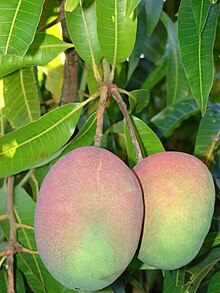Mangifera
| Mangifera | |
|---|---|
 |
|
| M. indica fruits | |
| Scientific classification | |
| Kingdom: | Plantae |
| (unranked): | Angiosperms |
| (unranked): | Eudicots |
| (unranked): | Rosids |
| Order: | Sapindales |
| Family: | Anacardiaceae |
| Subfamily: | Anacardioideae |
| Genus: |
Mangifera L. |
| Synonyms | |
|
Phanrangia poilanei Tardieu |
|
Phanrangia poilanei Tardieu
Mangifera is a genus of flowering plants in the cashew family, Anacardiaceae. It contains approximately 69 species, with the best-known being the Common Mango (Mangifera indica). The center of diversity is in subtropical and tropical South Asia and Southeast Asia, while the highest number of species occur in India. They are generally canopy trees in lowland rainforests, reaching a height of 30–40 m (98–131 ft).
Mangifera species are widely cultivated in Asia and elsewhere. More than 27 species in the genus bear edible, fleshy fruits, especially the Common Mango (M. indica). Others, such as M. foetida, yield astringent fruits that can be eaten pickled.
The earliest fossil species thought to be related to Mangifera is Eomangiferophyllum damalgiriense from the upper Paleocene of northeastern India. Leaves have also been reported from the Paleocene of Japan and the Eocene of Germany. Leaf compressions with a close affinity to Mangifera have been collected from Oligocene or early Miocene sediments in northern Thailand.
...
Wikipedia
